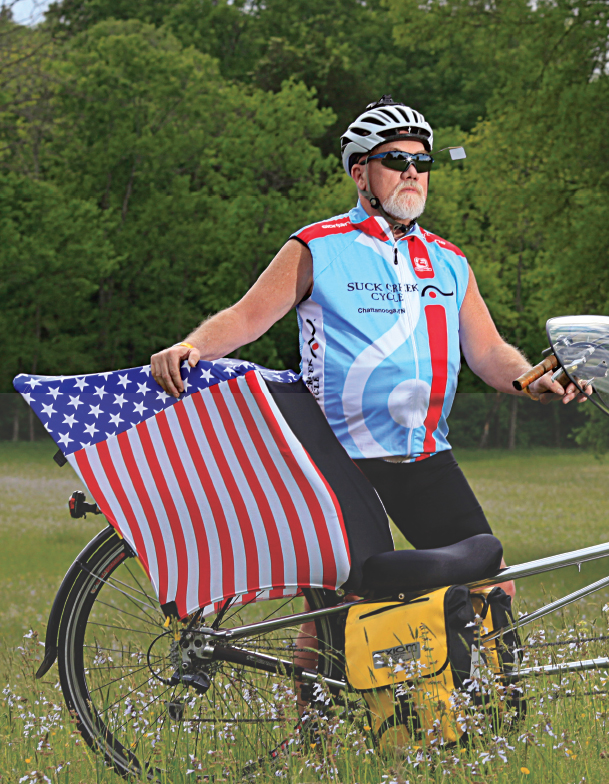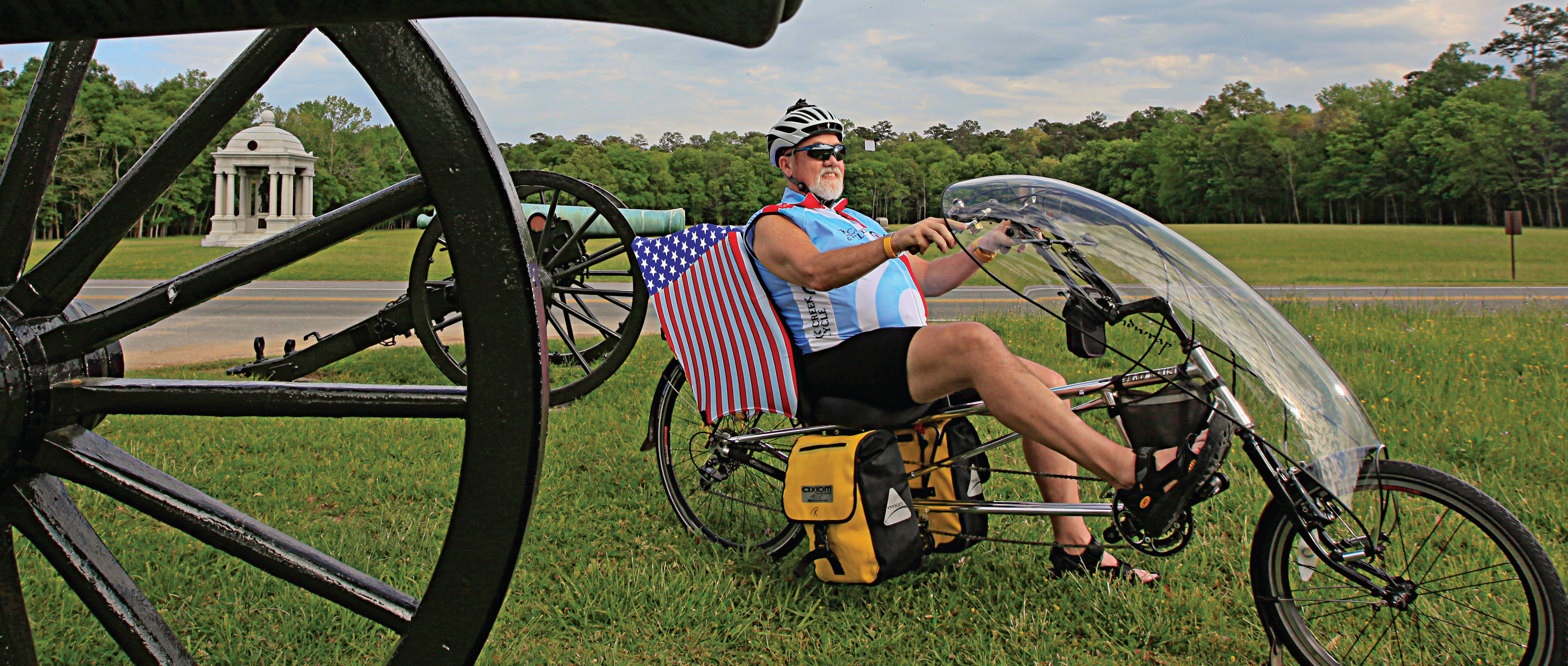Wanderlust WON-der-luhst German, from wandern to wander + Lust
First Known Use: 1875
noun: strong longing for or impulse toward wandering
The German word "wanderlust" has gotten a lot of attention lately. This February a movie by that title hit theaters, with Jennifer Aniston and Paul Rudd abandoning their Manhattan lives in hopes of finding happiness outside the city. The Wanderlust Festival launched in 2009 celebrating music and yoga in California and Vermont.
But when 60-year-old, bald grandfather Bob Hopkins uses the word in a conversation over soup and a sandwich you get the feeling he had a severe case of wanderlust before wanderlusting was cool.
"I've always had a two-wheel wanderlust," the Hixson cyclist says. "I like the idea of going somewhere under my own power with just my own energy and determination." At the end of this month, Hopkins will pedal his recumbent bicycle "Silver Sam" 400 miles from Chattanooga to Savannah, Ga. on a tour of Civil War sites.
This isn't the first time his lust has gotten the best of him. In 1988 he pedaled 350 miles from Memphis to Chattanooga. Twenty years later he took a 750-mile jaunt from Chattanooga to Canada. A month later he pedaled 450 miles to the Gulf of Mexico.
But don't try to Google those routes to double-check his mileage figures. "The route I go is never as straight as the Interstate," he says.
Early Symptoms and Diagnosis
When Hopkins diagnoses himself with wanderlust, you should trust him - he has a doctorate in psychology. And like all good psychologists, he can trace some of his adult behavior to his childhood.
"I'm an only child so I like to ride alone," he explains. He can remember the first time the wanderlust hit him. He was 12 years old, living in Indiana when he hopped on his bicycle and pedaled seven miles to his middle school for no specific reason. Forty-eight years later, he still relishes in the spontaneity of it all. There's never an ironclad itinerary or hotel check-ins to make on his trips.
"I've never stayed in a hotel while traveling," he says. "It's just the thrill of stopping wherever I want to stop." He practices what he calls "stealth camping."
He hangs his Hennessy Asym Ultralight hammock a few yards off the road, wherever he decides to squeeze his brakes for the last time that day. "I just find a stretch of woods that doesn't have a no trespassing' sign."
On his previous trips he's always had people offer him a place to stay the night, but the timing has
not worked out. Usually, the invitations come at conversations with strangers over breakfast or lunch. Staying with those impromptu hosts would eliminate a day or half a day of wandering, which hasn't been appealing for Hopkins so far. On his upcoming trip though, the pace will be a little different.
Instead of the average 90 to 115 miles a day of his previous sojourns, he's planning about 40 to 70 miles each day to give him time to explore Civil War sites. Visiting those historical waypoints during a time when the country is commemorating the war's 150th anniversary will be a major focus of the trip for Hopkins, a confessed Civil War buff. His trip will include stops at sites in Chickamauga, Ringgold, Resaca, Kennesaw, Stone Mountain, Madison, Milledgeville, Sandersville and Savannah. "I could easily have been a history teacher," he says. "(The 150th) certainly played a part in the trip."
Future Prognosis
Even at 60, Hopkins' wanderlust still has flare-ups. He's planning at least three more major rides - the shortest of which will be 444 miles.
And if his luck and street smarts continue, there's no reason to believe he can't do them. He's never had a major spill, never been run off the road by a car and has avoided equipment failure. "When I went to Canada and to the Gulf I didn't even have a flat tire," he says. He runs on Schwalbe Marathon tires and brings spokes, cables, tools and other gear with him, just in case.
"When you're out 200 or 300 miles from the bike shop you don't want any serious problems," he explains. But he's had some close calls. Twice he's pedaled within site of funnel clouds - once in Indiana and once near Shelbyville, Tenn. He also thought he had a close encounter with a bear while camping in a church's picnic pavilion in northern Tennessee. When he peeked out of his hammock, though, all he saw was a "humongous" dog rooting around in a trash can.
"He was tearing it up, too," Hopkins remembers. This fall or next spring he hopes to pedal the Natchez Trace, a 444-mile corridor from Nashville to Natchez, Miss., designated by the National Park Service to highlight American Indian sites. He also hopes to ride the 2,000-mile route of the Underground Railroad that escaped slaves used to travel from plantations near the Gulf up to free northern states and Canada. By the time he is 70, Hopkins wants to pedal from the Atlantic to the Pacific.
The lust for the open road, it seems, never goes into remission. "Part of the reason is the excitement of each new day - never knowing what new friends I will encounter and never knowing what new adventure will lie around the next bend in the road," he explains.
Is that a symptom of his wanderlust - or is that the cause?
Get Bent
Bob Hopkins, the psychologist, also applies his expertise good-naturedly to recumbent riding, particularly when it comes to social norms and perception.
"You don't see a lot of young guys on 'bents," he says, laughing. "The stereotype is old, bearded sort of paunchy guys and I sort of fit that stereotype."
The unconventional bikes are eye-catching and always elicit questions from walkers and other cyclists when Hopkins pedals on the Riverwalk or at the Chickamauga Battlefield. "I've always said if you don't like attention don't ride a 'bent," he jokes.
Fellow recumbent cyclist Art Hagood of Signal Mountain agrees. "I can ride (the Riverwalk) in one hour," he says. "It usually takes me three hours. That's how many people stop me and ask about it."
Recumbent bikes are praised for comfort and kindness to joints, known for being gentler on wrists, necks and knees than uprights. Hagood, who has several long-distance rides under his own belt, including rides across Alabama, Tennessee and Wisconsin, went so far as to call upright bikes "torture machines." The 'bents disperse weight better across the rider's back and rear end instead of just the rider's arms and crotch, he explains.
Hagood runs a recumbent shop called Easy Chair Recumbent Bikes out of his garage on Signal. "There is no pain," he says. "If a recumbent is set up for you correctly, nothing hurts."
Recumbents usually run from about $600 for beginner bikes to $9,000 for carbonfiber racers, but like upright bikes, the cheap models are heavy and can weigh as much as 50 pounds. A $1,500 to $2,000 'bent is a more realistic starting price for a bike that will weigh about 30 pounds.
Hopkins estimates there are probably 50 to 75 'bent bikers in the Chattanooga area. Both riders say cost and weight are two reasons why the bikes haven't quite caught on. "They cost more, they're heavier and they're not the 'in' machine," Hagood explains.
But if the coolness factor isn't your concern, the bikes are great. That's why Hagood, 72, says it's perfect for him.
"Older folks don't care what you think," he says.


